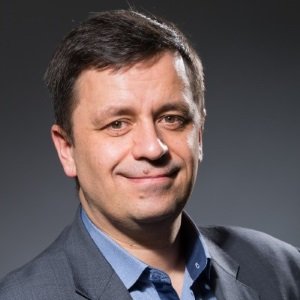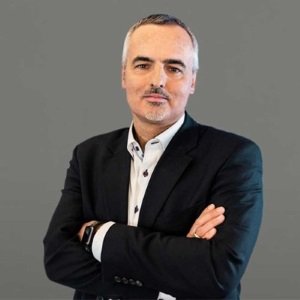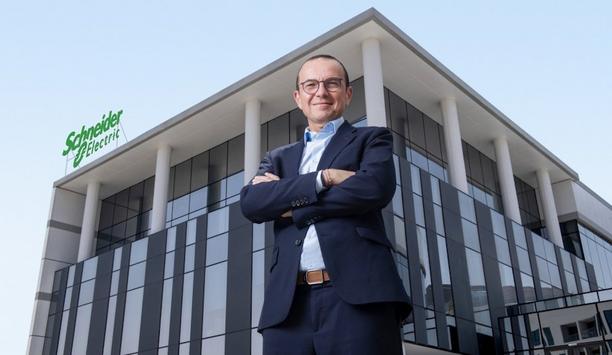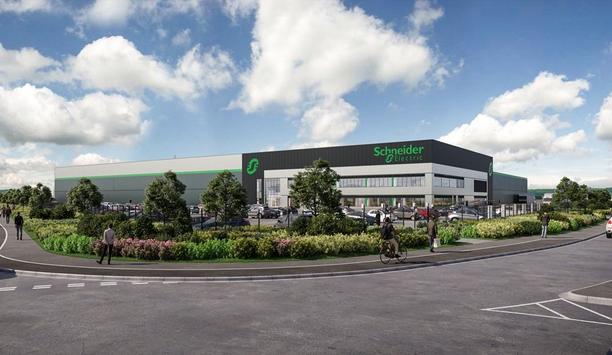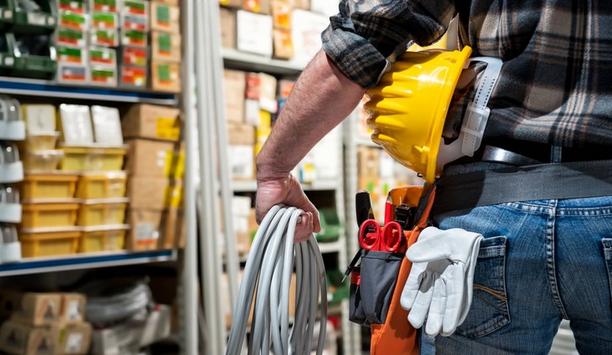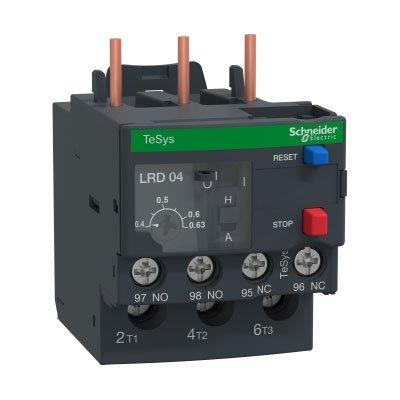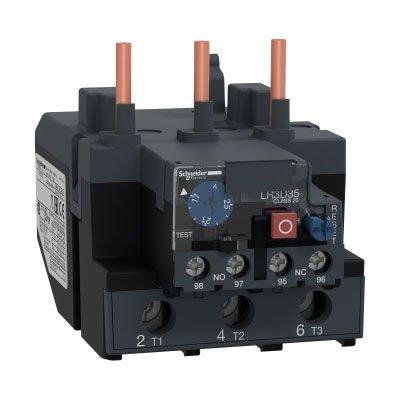Schneider Electric - Experts & Thought Leaders
Latest Schneider Electric news & announcements
Schneider Electric, the pioneer in the digital transformation of energy management and automation, launched its first Impact Building in Dubai as part of its new Impact Buildings Program. As the world’s most sustainable company, Schneider Electric’s Impact Buildings Program aims to drive sustainability through its own global commercial real estate using best-in-class EcoStruxure™ solutions, software, and services. These include EcoStruxure Building Operation, EcoStruxure Power Monitoring Expert, EcoStruxure Building Data Platform and Planon Integrated Workplace Management. combination of electrification and digitalization The interconnectivity of these solutions will drive sustainability, resilience, and efficiency The interconnectivity of these solutions will drive sustainability, resilience, and efficiency as well as improved occupant experience, demonstrating how the combination of electrification and digitalization — termed ‘Electricity 4.0’ by Schneider Electric — can transform sites into next-generation buildings. The NEST, Schneider Electric’s new office in Dubai, UAE, is over 10,000 sqm, catering to more than 1,000 employees and is home to Dubai’s first Schneider Electric Global Innovation Hub, an immersive experience area, where customers can have a hands-on demonstration of EcoStruxure™ solutions. Energy consumption reduction It will also host a dedicated Training Center for customers and partners and will focus on youth empowerment by developing local talent and equipping the next generation with the skills needed to drive the region’s clear energy future. The NEST expects an energy consumption reduction of 37% compared to the previous local site and provides a targeted saving of 572 metric tons of CO2 emissions, the equivalent to the annual electrical power consumed by around 77 homes. Model for next-generation buildings Schneider Electric is setting a model by showcasing to clients and partners the intelligent spaces With buildings accounting for 37% of global carbon emissions, Schneider Electric is setting a benchmark by showcasing to customers and partners the intelligent, sustainable spaces its technology can create. The Impact Buildings Program will roll out across additional new sites well as existing buildings by retrofit over the next 18 months, creating a model for next-generation buildings. Redefining building operations Manish Kumar, Executive Vice President, Digital Energy at Schneider Electric, said: "We are walking the talk and creating the vision of what’s possible by transforming our own sites to show that buildings must evolve to meet tomorrow's business needs. Now is the time to rethink buildings." He adds, "We are shaping a future where buildings don't just stand — they intelligently adapt and seamlessly connect to your business, your people, and your purpose. With EcoStruxure™ and Planon enterprise software, we are redefining building operations." standards for innovative and commercial spaces Commenting on the building launch in Dubai, Olivier Blum, Chief Executive Officer, Schneider Electric, stated: "The NEST is more than a building. It is a statement of intent. We are honored to have inaugurated this landmark project in the UAE, which demonstrates how digitalization and electrification can accelerate national net-zero goals while creating world-class environments for people to collaborate, innovate, and grow." Olivier Blum adds, "This new Dubai hub is the first of Schneider Electric’s Global Impact Buildings program and showcases how smart, connected technologies can revolutionize the built environment, setting new standards for innovative and sustainable commercial spaces while prioritizing occupant well-being."
Schneider Electric, the pioneer in the digital transformation of energy management and automation, is investing £42 million in a new manufacturing facility in Scarborough, North Yorkshire. More than 200 jobs will be created to meet the increased demand for electrical equipment to drive the UK’s move to cleaner energy including renewable energy sources, electric vehicles, and intelligent, energy-efficient buildings. sustainable design The site, which is almost triple the size of Schneider Electric’s existing Scarborough facility, is a blueprint for sustainable design and operations in the manufacturing industry. It is poised to become a net-zero plant and will use modern technology to reduce energy waste and maximize the use of renewable energy. It is expected to be net-zero in Scope 1 and 2 emissions when it opens in early 2025. 30% of the facility’s energy will be produced by a state-of-the-art solar energy system, with solar panels covering 50% of the roof, to ensure the building harnesses solar energy efficiently. Any energy consumed on site from the national grid will be "renewably certified". An intelligent Building Management System, based on Schneider Electric’s EcoStruxure platform, will ensure energy-efficient operations including light sensors, automated heating and cooling. It will feature one of the first fully electric paint lines in Europe to support decarbonized operations. It is targeting a BREEAM 'Excellent' rating, setting it apart in terms of sustainable construction standards. sustainable transport options The site is designed to be environmentally friendly, with sustainable transport options for employees. Employees will have access to 30 EV chargers on-site. There will be dedicated cycling racks, shelters, and showers on site for bike riders. Work is underway with Natural England to create a habitat for protected species. It will promote biodiversity by retaining as many of the existing trees and natural features as possible. Scarborough facility It specializes in the manufacture of low-voltage switchgear which protects and distributes electricity Scarborough is a long-established manufacturing base for Schneider Electric, currently employing 450 people. It specializes in the manufacture of low-voltage switchgear which protect and distribute electricity and are crucial to the rollout of sustainable and energy-efficient operations such as EV charging infrastructure and net-zero buildings. Sustainability Kelly Becker, President at Schneider Electric, UK & Ireland, Belgium & Netherlands said, “Sustainability is at the core of our purpose, culture, and business." "We’re proud to be investing in and developing innovative solutions that will deliver immediate and lasting decarbonization in the UK while bolstering the creation of local, green jobs in Yorkshire." net-zero “The region has long been part of our operational presence in the UK, and we’re excited to expand this as part of our commitment to investing in the UK’s green economy." "The new facility in Scarborough represents a pillar of innovation in net-zero and one which will be an industry benchmark for the transition to sustainable, energy-efficient buildings.” Industrial Strategy Business and Trade Secretary Jonathan Reynolds said, "This huge investment from Schneider Electric will not only safeguard existing jobs but create 200 new ones." "Increasing investment is a mission at the heart of this government, and our modern Industrial Strategy will help us deliver long-term, stable growth that supports skilled jobs." clean energy superpower “Our commitment to becoming a clean energy superpower is steadfast, and investments like these in North Yorkshire make a huge contribution to bolstering the UK as a pioneer in energy management and automation." "We’re showing investors that Britain is back as a stable place to do business, helping to secure the investment needed to make every part of our country better off.” engineering hub of excellence David Skaith, Mayor of York and North Yorkshire said, “York and North Yorkshire has a well-established and thriving manufacturing sector, which is home to an abundance of pioneering and specialist companies. So, it is fantastic to see Schneider make this huge investment in their future in Scarborough. " “This new manufacturing facility will drive new, quality jobs in Scarborough and help us go beyond net zero to become England’s first carbon-negative region. Pioneers like Schneider attract other manufacturers, and we welcome the investment as we look to become a production and advanced engineering hub of excellence.” Green technologies Stephen Phipson, Chief Executive of Make UK said, “This is a marvelous example of how sustainable manufacturing can be achieved, creating many highly skilled jobs in the process." "Green technologies are going to be the solution to many of the challenges that we face and Schneider should be applauded for pioneering this facility. It is an exemplar model for other manufacturers to follow when they build new facilities.” relocating operations With its head office in London, there are a further 13 operational sites across the UK Schneider Electric is a group that employs 5,000 people in the UK and Ireland. Globally, it closed in 2023 with a turnover of 36 billion euros. With its head office in London, there are a further 13 operational sites across the UK that specialize in energy management solutions including automation and control, electrical distribution, and building management, amongst others. Operations will relocate to the new facility at Scarborough Business Park, less than 500m from Schneider Electric’s existing premises. supporting people, the community, and the planet Schneider Electric will be its anchor tenant, which will be managed by principal contractor Caddick Developments. Alistair Smith, Director at Caddick Developments said, “As a long-standing Yorkshire business with sustainability at its heart, we are delighted with Schneider Electric’s commitment to Scarborough Business Park which further bolsters our strong track record of delivering industrial projects throughout the UK as we seek to build developments that support people, community and planet." gold standard “Schneider Electric’s expansion will deliver much-needed jobs for Scarborough and its commitment to the net-zero agenda will ensure that this facility operates as a gold standard for sustainable growth and energy efficiency.” The investment in Scarborough is in addition to a £7.2 million facility upgrade to Schneider Electric’s site in Leeds, announced in October 2023, meaning the company will create more than 300 jobs in Yorkshire over the next ten years.
Schneider Electric, the pioneer in digital transformation of energy management and automation, has announced the launch of its Schneider Electric Training program in the UK and Ireland (UK&I). Schneider Electric’s vision in the UK&I is to create a best-in-class approach to training, unifying specialist academies, courses, and digital campuses into a holistic offering - Schneider Electric Training. skills gap The move is in response to the chronic skills gap in engineering and the vital role that training plays in addressing the growing complexities associated with digital transformation. The extensive program covers everything from AI, the automation of machinery and equipment, to innovations in power and energy management, and safety standards and regulations. training options and resources It will be delivered via several specialist academies for in-person courses and a digital campus offering Schneider Electric Training will provide customers, partners, and engineers with a single point of access to the vast array of training options and resources available, covering Schneider Electric solutions, industry-focused courses, and professional accreditations. It will be delivered via several specialist academies for in-person courses and a digital campus offering on-demand courses for Continuing Professional Development (CPD) via the mySchneider portal. introducing academies Two academies are already up and running, with three more due to be launched by the end of the year. The Safety Academy in Telford offers a range of Schneider Electric and professional training courses to ensure the safe operation of electrical equipment and site safety, including Competent Person certification and City & Guilds assured Authorised Person training. Automation Academy It is designed to take students from basic product understanding through to advanced programming The Automation Academy in Coventry offers a comprehensive curriculum covering Schneider Electric’s automation portfolio. It is designed to take students from basic product understanding through to advanced programming of both legacy and current technology, including Programmable Logic Controllers (PLC), Variable Speed Drives (VSD), Human Machine Interfaces (HMI), Motion Control, and Robotics. electrical backbone "Organizations are becoming more dependent on their electrical backbone to support operations, digital transformation, automation, and manufacturing," said David Pownall, Vice President (VP) of Services at Schneider Electric UK and Ireland. He adds, "Electrical engineers and their specialist expertise are critical to the installation, safety, and maintenance of this electrical infrastructure." Modernization and performance David Pownall continues, "There is an urgent need to build skills to embrace new technologies, drive modernization, improve performance, reduce downtime, and comply with changing safety regulations. Not only that, but training is critical to career enhancement and a key foundation of a positive employee experience, attracting and retaining people when we’re facing a significant skills gap crisis." He concludes, "Smarter engineers, equipped with the skills needed today and a clear development path to build expertise for the future, make for smarter businesses."
Insights & Opinions from thought leaders at Schneider Electric
The electrical industry is expected to have a labor shortage of about 60,000 workers by 2026. A labor shortage in the electrical trade is not inevitable, but it is likely to continue if the industry does not take steps to address the issue. Like other skilled trades, the electrical industry is facing challenges that could contribute to a labor shortage, including an aging workforce, a lack of interest among younger generations, and competition from other industries. However, there are strategies the industry can implement to address these challenges and attract a new generation of workers. These strategies include increasing awareness of the benefits and opportunities of skilled trades, investing in training and education programs, improving working conditions and compensation, embracing technology, promoting diversity and inclusivity, and collaborating among industry, education, and government. Improving working conditions Factors in the current labor shortage in the electrical industry include: Aging workforce: Many workers in the electrical industry are nearing retirement age, and there are not enough younger workers to replace them. This has led to a shortage of skilled workers with many years of experience in the industry. Lack of interest in the trades: There has been a decline in the number of young people pursuing careers in the skilled trades, including electrical work. This is due in part to a focus on four-year college degrees as the preferred career path, as well as a lack of awareness of the benefits and opportunities of skilled trades. Competition from other industries: The electrical industry is competing with other industries, such as construction and manufacturing, for skilled workers. Training and education: Training and education are critical for developing the skills and knowledge necessary for electrical work. However, there is a shortage of qualified trainers and educators. Increasing demand: The demand for electrical services is increasing, particularly in areas such as renewable energy and smart grid technology. Attracting and retaining workers To attract and retain workers, the electrical industry must offer competitive wages and benefits One strategy to address the labor shortage is to increase awareness of skilled trades and to promote the benefits of a career in the electrical industry through outreach programs in schools, career fairs, and other events. Providing access to quality training and education programs that develop the skills and knowledge necessary for electrical work is crucial for attracting and retaining workers. This can be done through apprenticeship programs, vocational schools, and community colleges. To attract and retain workers, the electrical industry must offer competitive wages and benefits, as well as a safe and supportive work environment. This includes offering training and development opportunities, flexible schedules, and opportunities for advancement. Inclusive work environment The electrical industry is changing rapidly, and workers must be equipped with the latest technology and tools to stay competitive. Providing workers with training and access to the latest technology can help attract and retain workers. The electrical industry should actively promote diversity and inclusivity to attract a wider pool of workers. This includes efforts to recruit workers from underrepresented groups and create a welcoming and inclusive work environment. The electrical industry is changing rapidly, and workers must be equipped with the latest technology Companies in the electrical industry are addressing the labor shortage problem by investing in workforce development programs and initiatives. For example, Schneider Electric has developed a comprehensive workforce development program called the Schneider Electric Energy and Automation Training (SEAT) program. The SEAT program provides training and certification for employees, customers, and partners in areas such as energy management, automation, and digital transformation. Developing training programs Siemens has developed several initiatives to address the labor shortage in the electrical industry. These initiatives include apprenticeship programs, vocational training programs, and partnerships with educational institutions to develop training programs. Graybar, a distributor of electrical products and solutions, has developed a workforce development program called Graybar University to provide training and education for employees, customers, and partners in areas such as lighting, automation, and safety. Joint apprenticeship training program Collaboration among industry, education, and government is crucial for developing solutions The International Brotherhood of Electrical Workers (IBEW) and the National Electrical Contractors Association (NECA) have developed a joint apprenticeship training program that provides training and education for individuals looking to enter the electrical industry. The program provides on-the-job training and education in areas such as electrical theory, safety, and installation. Collaboration among industry, education, and government is crucial for developing solutions to the labor shortage in the electrical industry. This includes partnerships between industry and education institutions to provide training and education programs, as well as government initiatives to support workforce development in the skilled trades.
Schneider Electric LR3D380 Thermal Overload Relay
Schneider Electric LR3D046 Thermal Overload Relay
Schneider Electric LR3D3522 Thermal Overload Relay














